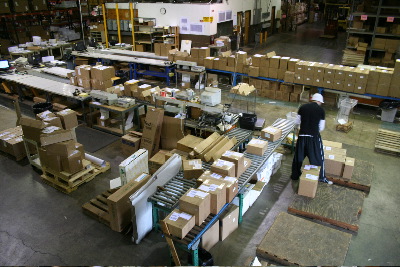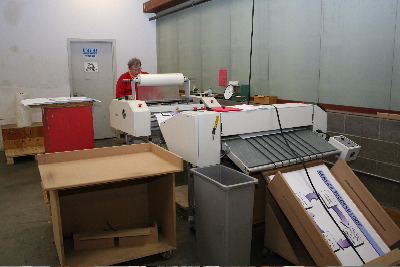Empowered: DDI Gives Employees Responsibility

It may sound like a popular television crime drama, but CSI, the in-plant facility serving Development Dimensions International (DDI), is writing its own script by leveraging the latest printing technologies, empowering its dedicated staff, and keeping focused on providing the best possible customer service.
The evidence is clear that this in-plant has taken a page from its Pennsylvania-based corporate parent, a global human resources consulting company specializing in the design and implementation of selection systems to help companies hire better employees faster. DDI prides itself on identifying and developing exceptional leaders who will create a high-performance workforce. CSI takes that goal to heart.
Offering proof of the company’s hiring prowess, Steven Horton, CSI’s facility leader, points out that the average length of service of the in-plant’s nearly 40 employees exceeds 15 years. Keeping the staff engaged and challenged gives them something to look forward to, he notes. The hiring selection system the shop uses is also important.
“If you bring the right people in to fit the environment and the job they need to do, it’s better for both sides,” advises Horton, who utilizes DDI’s targeted selection behavioral interviewing principles and tools. “Not everyone fits into the open, empowered environment we have here. Some people like to come in and be told what to do and go home at the end of the day and forget about it. Those folks probably wouldn’t fit in real well here.”
CSI empowers its employees by implementing self-directed work teams, handing the staff responsibility for their own work areas, their costs, productivity and process improvements. The teams are led by rotating communication point people, who attend meetings and bring back information for others in their group. CSI—which originated as a commercial printing operation called Customer Service Inc. before becoming a dedicated in-plant—comprises more than 51,000 square feet of printing, warehouse and shipping space, and has a flexible annual budget of $6 million. It has used the self-directed work team model since the early 1990s.
“A lot of printers I know spend a lot of time evaluating new equipment, and that is the right thing to do, but they don’t spend enough time evaluating new employees,” says Horton, who’s been with the in-plant for more than 20 years. “Anybody can buy the equipment, but to really get the most out of any equipment, you have to have the right people—people that are willing to look for a better way, no matter what tool you give them.”
Looking to get the most out of its equipment, CSI moved to a just-in-time platform, originally due to a lack of warehousing space. The shop was doing long runs and storing training products over a period of several years, Horton recalls, and began dealing with obsolescence and space issues. Seeking to avoid the hidden costs of operating that way, Horton decided to adopt a lean manufacturing model.
“If you are going to lower your run lengths, and do it economically, you need to reduce makeready times and streamline your processes to cut out waste and extra labor steps,” Horton contends. “Our makereadies on our five-color press went from about 45 minutes to 15 minutes.” In fact, the in-plant was so successful with its efforts, The Graphic Arts Technical Foundation (GATF) used CSI as a model to create its Makeready Reduction course.
The Canonsburg, Pa.-based shop has a history of collaborating with the GATF, which lies just 20 miles away, on the outskirts of Pittsburgh. Horton has provided his expertise as a speaker and trainer at many GATF conferences and events, and CSI employees have attended various training programs put on by the industry association. CSI also was one of the original members of GATF’s SPC (statistical process control) Users Group.
Being just a half hour’s drive from GATF really came in handy when the in-plant was looking to purchase its Xerox iGen3 110. Horton visited GATF to see its iGen3 as part of his quest for a digital printing solution to produce short-run, full-color, custom training materials.
Automated Production
“My ultimate goal was to have a finished, saddle-bound workbook come out of the end,” Horton explains. Leveraging a Xerox FreeFlow front end and Oracle MIS software, client service representatives are now able to choose from 50,000 different product offerings in CSI’s Oracle system, which can determine if it’s a print-on-demand item. Oracle talks to the front end of the iGen3, generates an order number and identifies the product and quantity to be produced. The correct printing instructions and PDF files are identified, and the job goes to the queue of the proper machine. It is then printed, finished, boxed and shipped.
“It really streamlined the process and took out a lot of the labor and the steps,” Horton raves. “We eliminated a lot of touch points, decisions and opportunities for error by streamlining the process.”
On the back end of the iGen3, which has been churning out more than a million prints per month, CSI installed a DocuSheeter iG roll feed system, from Lasermax Roll Systems, to boost productivity. The DocuSheeter feeds cut sheets from 50? diameter rolls to the iGen3 so the digital press is never down for re-loading. Since the shop uses a lot of the same text-weight paper for its workbooks, the roll feed system allows operators to focus on what they are doing on the front end of the machine. An in-line preprint punch, a saddle binding unit and a three-hole punch also help speed production.
The shop utilizes a trio of Hewlett-Packard (HP) wide-format printers, which operate 10 to 12 hours per day, producing close to 6,000 wide-format prints per month. CSI uses the HP printers to produce wall charts, learning aids, marketing prints and trade show work.
“HP laughs when they come in here because they think one of our large-format printers has the largest volume of any of their machines anywhere,” Horton says.
The addition of the digital printing and large-format equipment has allowed CSI to more efficiently use its three 25? Heidelberg offset presses, allowing the presses to focus on longer-run jobs. As part of its just-in-time system, the shop doesn’t produce any more than an eight-week supply of any materials.
Horton has also implemented an automated, online stationery and business card ordering system, available through the company intranet.
In the CSI shipping department, employees typically handle 250 boxes a day, boasting an on-time shipping rate of 99.98 percent. Jobs are transported to locations worldwide.
“Folks in shipping get a real kick out of shipping things as far away as China,” Horton quips.
None of these efforts has gone unnoticed by DDI or its customers, Horton stresses.
“When the company conducts client surveys, customers list the in-plant higher than any other part of DDI,” Horton informs. “I think that goes back to our customer service focus. We make sure they get what they need, when they need it, every time.”
Horton adds that DDI considers CSI as a competitive advantage over its industry rivals, since it can create custom training materials and provide top-notch customer service.
“We brought the operating committee here and gave them a tour of the facility to show them the print-on-demand process and how well we do manufacturing, distribution and fulfillment,” Horton concludes. “It really opened up some eyes of upper management, and helped our sales force leverage that competitive advantage with our customers.”
Related story: In-plant Adds Cut-Sheet Inkjet Press
- Companies:
- Xerox Corp.

 International Man Of Print
International Man Of Print
 From Five to Three: Georgia In-plant Boosts Quality, Cuts Costs, Trims Fleet
From Five to Three: Georgia In-plant Boosts Quality, Cuts Costs, Trims Fleet
 Sponsor Content
Major Digital Press Upgrade Retools Houston Metro for Success
Sponsor Content
Major Digital Press Upgrade Retools Houston Metro for Success
 In-plant Installs Two Nuveras Despite Xerox Plans to End Manufacturing
In-plant Installs Two Nuveras Despite Xerox Plans to End Manufacturing
 New Xerox PrimeLink C9200 Series Production Press
New Xerox PrimeLink C9200 Series Production Press
 Xerox at PRINTING United Expo 2024
Xerox at PRINTING United Expo 2024






